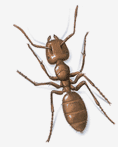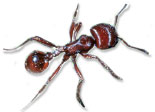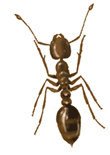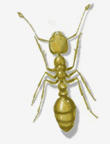Ants
 Argentine Ant - Iridomyrmex Humilis
Argentine Ant - Iridomyrmex Humilis
Appearance: From light to dark brown, about one-tenth inch long; antenna has 12 segments.
Habits: Readily adaptable and can nest in a great variety of situations; colonies are massive, and may contain hundreds of queens; nests are usually located in moist soil, next to or under buildings, along sidewalks or beneath boards; travel in trails; forage day and night.
Diet: Omnivorous; can eat almost anything; prefer sweet foods.
Reproduction: Eggs are white, laid in summer; larvae emerge after about 28 days; adult stage reached in about 74 days.
Other Information: Has no important natural enemy in the United States.
 Carpenter Ant - Genus Camponotus
Carpenter Ant - Genus Camponotus
Appearance: Among the largest ants, from one-fourth to three-eighths inch long; most common species is black, but some have reddish or yellowish coloration; workers have large mandibles.
Habits: Normally nest in dead portions of standing trees, stumps or logs, or burrow under fallen logs or stones; invade homes in search of food; nests inside homes can do great damage; hollow out "galleries" in wood that are so smooth they appear to be sandpapered.
Diet: Do not eat wood; will feed on nearly anything people eat, particularly sweets and meats; also feed on other insects.
Reproduction: Queen lays 15 to 20 eggs the first year, and up to 30 eggs the second year; eggs complete their life cycle in about 60 days; worker ants can live up to seven years, while a queen may live up to 25 years.
Other Information: All kinds of houses, regardless of age or type of construction, are vulnerable to infestation and damage by carpenter ants; very difficult to control; colonies can contain up to 3,000 workers.
Harvester Ant - Pogonomyrmex rugosus
 Appearance: Less than 1/16-1" (1-15 mm) long, are mostly black, brown, or reddish.
Appearance: Less than 1/16-1" (1-15 mm) long, are mostly black, brown, or reddish.
Habits: They have a complex social structure usually consisting of a wingless worker caste composed entirely of sterile females and a reproductive caste made up of winged, fertile males and females. But some species do not have a worker caste, and some reproductives do not have wings. Ants have a slender "waist," or pedicel, of 1 or 2 beadlike or scalelike segments between the thorax and abdomen.
Diet: Workers gather food, maintain and defend the nest, and tend eggs, larvae, and pupae. Most species are predators or scavengers, but a few harvest seeds, visit clusters of aphids to eat their sweet secretions, raise fungus for food in small underground gardens, or eat leaves cut from plants. Some species produce eggs, which are eaten by the queen and workers.
Reproduction: They differ from wasps in having distinctly elbowed antennae. Ants live in colonies in underground tunnels or in galleries in dead wood. From time to time, winged males and females emerge from the nest and perform a brief mating flight. After mating, the males die, and the females lose their wings and return to the ground to start a new colony.
Other Information: When disturbed, most ants are capable of "biting" or "stinging" people. Warning These ants are capable of delivering a sting which does not hurt at first, but can result in intense pain and swollen lymph nodes, particularly if the victim is attacked by a number of workers.
Odorous House Ant - Tapinoma Sessile
 Appearance: Dark reddish brown to black, one-tenth inch long; antennae have 12 segments.
Appearance: Dark reddish brown to black, one-tenth inch long; antennae have 12 segments.
Habits: Nests found in a great variety of situations; in the home, often found nesting in the walls or beneath the floor; most likely to invade homes during rainy weather; travel in trails; forage day and night.
Diet: Honeydew melons in the wild; inside the home, they prefer sweet items.
Reproduction: Each female in the nest lays one egg a day; young reach adulthood in an average of 24 days; workers and females live for several years.
Other Information: When crushed, give off very unpleasant odor; colonies are very large, but can be driven away by invading Argentine ants.
 Pavement Ant - Tetramorium Caespitum
Pavement Ant - Tetramorium Caespitum
Appearance: Light brown to black, appendages lighter than rest of the body; about one-tenth inch long; parallel lines on head and thorax; antennae of 12 segments.
Habits: Invade homes foraging for food throughout the year; nests are outdoors under stones, along curbing or in cracks of pavement; can nest indoors in walls and under floors.
Diet: Omnivorous; will eat many things, but prefer greasy and sweet foods.
Reproduction: Queen produces five to 20 eggs per day; brood develops in about 40 days; young go through 3 larval stages.
Other Information: Slow-moving; a particular nuisance around homes with slab-on-grade construction.
 Pharaoh Ant - Monomorium Pharaonis
Pharaoh Ant - Monomorium Pharaonis
Appearance: Very small; light yellow to red, with black markings on abdomen; about one-sixteenth inch long.
Habits: Depends on artificial heating in human dwellings to survive; infestations commonly occur in food service areas; will nest in any well-protected and hidden areas throughout a structure; can nest outdoors in lawns or gardens.
Diet: Food of all types, but especially sweets; will also eat other insects.
Reproduction: Grows from egg to adult in about 45 days; females live as long as 39 weeks and can lay about 400 eggs; workers only live up to 10 weeks.
Other Information: The most persistent and difficult of all household ants to control; very large colonies, with up to several million workers and thousands of queens.